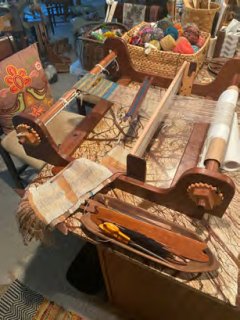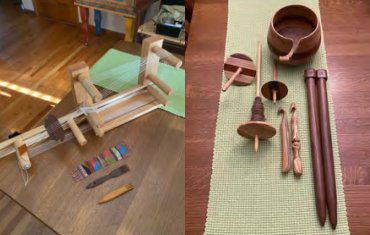AgEBB-MU CAFNR Extension
Green Horizons
Volume 25, Number 2
Spring 2021
Wood, Wool and the Weaving Shed
Lynn Barnickol

Collaborating with my spouse on related interests began when we reached retirement age. Our story begins as children. For my 10th birthday my Dad gave me a motorized scroll saw. Its reciprocating action generated more noise than sawdust, but it was good for cutting thin pieces of wood for making birdhouse parts and jigsaw puzzles. My degree in Wood Science helps me to understand wood and my wood shop has grown over the years to include a lathe, table saw, planer, bandsaw, sanders, and scroll saw.
 |
| Left: Traveler Loom, Right: Art yarn and bowl Photo credit: Lynn Barnickol |
Gail, my spouse, began sewing Barbie Doll clothes on her Mother's Singer sewing machine. Gail focused on fiber arts by taking high school and college level sewing and textiles classes. Her Dad provided encouragement by gifting her a sewing machine used to make some of her own clothing, including her wedding gown. Beyond her focus of sewing and textile arts, Gail also experienced the side tracks of getting married to me, moving numerous times, raising a family, and sewing many of our children's clothes and household accessories.
Fast forward to retirement. Gail started her adventures in wool by repurposing wool sweaters into purses, hats and mittens. She also wanted to learn to spin yarn from wool fleece. Adding a spinning wheel to her crafting collection ensured her passion for making art yarn that incorporates beads, buttons, and other small expressions into multi-thickness yarns of different colors. Those yarns are used in making fabric purses, scarves, hats, gloves, and other accessories. By taking a class at Hill Creek Fiber in Columbia, Gail learned about dying her own wool fibers from native plants such as wild blue indigo; coreopsis, black-eyed Susan; sumac; walnut leaves, bark, and hulls; Osage-orange shavings, and inner bark of black oak. Once yarns began to accumulate, it became obvious that a loom provided even more opportunities to use her growing collection of yarn.
 |
| Ridged heddle loom Photo credit: Lynn Barnickol |
Gail provided photos and asked if I could make her a ridged heddle loom. My response was yes! The obvious question we failed to ask of ourselves was: Have you ever woven anything? We did know our warp from our weft. We did know the shed is the gap made in the warp for the weft. We did not know about the neutral position of the heddle so we needed to remanufacture the heddle guides. Getting the tension of the warp set correctly was challenging. After some YouTube videos and some good-natured razzing, the ridged heddle loom was declared a success. She is able to make long textiles that are the raw material for dish towels, table napkins, and scarves. Some of Gail's yarn finds its way into her weaving projects.
Presently Gail and I continue to collaborate on making spinning and weaving tools made from wood. Those projects range from making lathe turned drop spindles that look similar to a toy top, but are an ancient method of spinning yarn.
We also made a stationary Navajo loom; A-frame tapestry looms, hand-held, portable tapestry looms, and an inkle loom. Rounding out the tool selection are battens for creating the shed; shuttles for passing the weft yarn through the warp; forks that fit through the warp to tightly pack the weft together, large diameter knitting needles, and crochet hooks.
The lathe is also used to make yarn bowls that look much like deep soup bowls, but have a slotted side for the yarn to pass through. Woods used in our projects include combinations of native Missouri walnut, cherry, sugar maple, white oak, red oak, elm, Osage-orange, yellow poplar, Kentucky coffeetree, and honeylocust. Cardwell Hardwoods in Jefferson City is the source of most of my wood, along with a few storm damaged trees.
 |
| Left: Inckle loom, Right: hand crafted yarn-work tools Photo credit: Lynn Barnickol |
Besides collaborating on fiber tools, we both team up in the kitchen and on gardening projects. Those endeavors lead to wood projects like salad bowls, cutting and charcuterie boards, stirring utensils, and pizza peels for the culinary arts. Seed pot makers and planting dibbers are for gardening. We also collaborated in designing and making bed frames, dining tables, and end tables. Wool and wood share similar letters, are comprised of fibers, and are raw materials that are attractive, practical, and can be sourced from renewable natural resources.
Collaboration on our interests, developed from childhood hobbies, is satisfying and pays off in retirement. We are in a small retail shop, the Art Bazaar, in Jefferson City and an ETSY Shop named TurnUpGreen.
